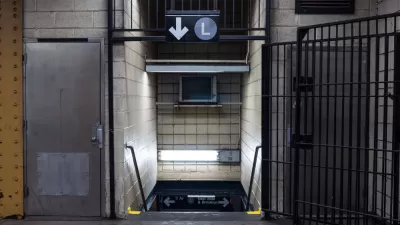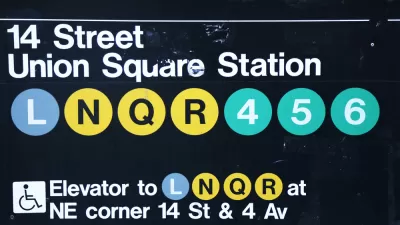Solo commuters crossing from Brooklyn to Manhattan on the Williamsburg Bridge are in for a rude awakening on April 27 when the L Train closes. To accommodate more buses and bikes on the 115-year old bridge, cars will need at least 3 people.

The L Train's Canarsie Tunnel under the East River between Brooklyn and New York carries 225,000 passengers daily. The tunnel, which consists of two tubes, each carrying one track, was damaged by Hurricane Sandy in 2012. Those people will need alternatives come April 27 when the tunnel is scheduled to close for 15 months.
"There is no room on the bridge itself for dedicated bus lanes or a bigger bike path," reports Winnie Hu for The New York Times. "So city transportation officials are squeezing in new bus and protected bike lanes on surrounding streets in Brooklyn and Manhattan to keep traffic flowing on and off the bridge."
The occupancy requirement will apply every day between 5 a.m. and 10 p.m. for all passenger vehicles, including taxis and ride-shares, in both directions. When plans were first released last December to make the Williamsburg Bridge the linchpin in the city’s efforts to come up with L alternatives, the carpool requirement was reserved only for rush hours.
Police officers will be stationed on the Manhattan side to hand out tickets to drivers violating the high-occupancy-vehicle requirements.
“The Williamsburg Bridge is critical to our subway and bus plans,” said Andy Byford, the president of New York City Transit, which operates the subway. “We’re doing everything we can to improve reliability on the rails and working closely with our city partners to get the infrastructure and enforcement we need to move our buses efficiently.”
Public transit
New bus service across the bridge will offer displaced L line commuters 80 buses per hour in each direction along four new lines. However, most commuters will resort to other subways.
Three lines, the J, M and Z, already use the Williamsburg Bridge. They are among the seven lines that will see an additional 1,000 daily trips when the L Train shuts down.
Gearing-up for more bikes
"Cycling on the Williamsburg Bridge’s two-way bike path is already the city’s busiest bicycle bridge crossing with 7,300 trips per day," notes the caption under the photo by Hiroko Masuike/The New York Times. According to Hu, bike traffic "is expected to double, or even triple."
The New York City Department of Transportation celebrated a green carpet roll-out on Nov. 15 for the opening of a new two-way protected bike lane along Delancey Street on the Lower East Side, providing a safer bike route to and from the Manhattan side of the bridge at the expense of the removal of one vehicle lane.
Planetizen contributor Camille Fink further explores the increase in bike infrastructure in "How New York’s L Train Shutdown Will Boost Cycling."
Hat tip to Annie Dawid.
FULL STORY: When the L Train Shuts Down, Will the Williamsburg Bridge Come to the Rescue?

Maui's Vacation Rental Debate Turns Ugly
Verbal attacks, misinformation campaigns and fistfights plague a high-stakes debate to convert thousands of vacation rentals into long-term housing.

Planetizen Federal Action Tracker
A weekly monitor of how Trump’s orders and actions are impacting planners and planning in America.

Chicago’s Ghost Rails
Just beneath the surface of the modern city lie the remnants of its expansive early 20th-century streetcar system.

Bend, Oregon Zoning Reforms Prioritize Small-Scale Housing
The city altered its zoning code to allow multi-family housing and eliminated parking mandates citywide.

Amtrak Cutting Jobs, Funding to High-Speed Rail
The agency plans to cut 10 percent of its workforce and has confirmed it will not fund new high-speed rail projects.

LA Denies Basic Services to Unhoused Residents
The city has repeatedly failed to respond to requests for trash pickup at encampment sites, and eliminated a program that provided mobile showers and toilets.
Urban Design for Planners 1: Software Tools
This six-course series explores essential urban design concepts using open source software and equips planners with the tools they need to participate fully in the urban design process.
Planning for Universal Design
Learn the tools for implementing Universal Design in planning regulations.
planning NEXT
Appalachian Highlands Housing Partners
Mpact (founded as Rail~Volution)
City of Camden Redevelopment Agency
City of Astoria
City of Portland
City of Laramie




























